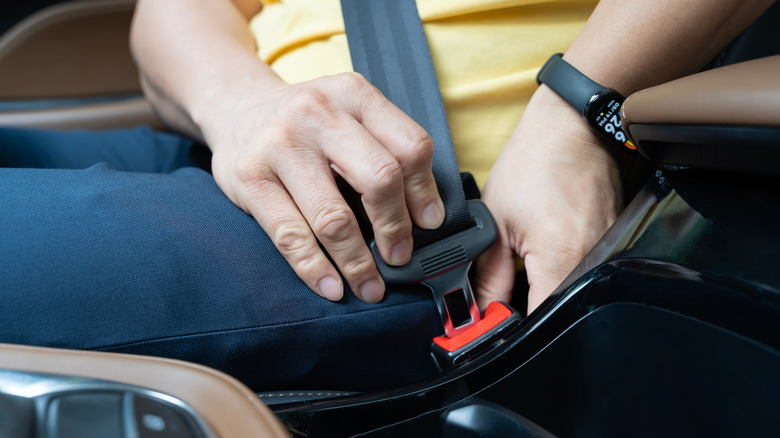What Is The Fabric Loop On A Seatbelt For?
No one ever hopes to get into a car accident, but when they do happen, your seat belt instantly goes from an elastic band you hardly think twice about to a literal life-saving device. From the first car to use seat belts until today, they have evolved in their efficiency and reliability, with every detail engineered to maximize safety. One particularly perplexing design detail imbued into some seat belts is the inclusion of an additional stitched-in fabric loop located close to the buckle. While seemingly pointless, these attachments play an essential role in the case of a serious accident.
Also known as an energy management loop, these mechanisms are designed to tear off during intense collisions. This gives the belt itself a few extra inches when it is thrust forward, further preventing your body from serious impact. By staying tucked away the rest of the time you drive, the loop economizes your seat belt's length and performance. By being stitched in, it adds an extra bit of tightness to the seat belt overall to enhance stability. These qualities also allow the loop to control the height of the buckle and stop it from sliding down into the chair.
One of the most interesting qualities of seat belt loops are that, for cars they're found in, they are only located on the passenger side and back seats. Leaving the driver's side absent of this essential safety feature seem odd — until you learn the reason.
A seat belt loop on the driver's side could lead to disaster
While some newer models have replaced their seat belts' energy management loop with other efficient alternatives, cars nowadays that still possess these features are not uncommon. But in the cars that do have them, you'll never find any placed on the driver's seat belt. In reality, the same qualities that make energy management loops such invaluable safety tools can have the very opposite effect and make them a serious hazard for drivers.
In the unfortunate occurence of an accident, it's important that the driver remain as stable as possible. This is because, no matter how far away from the steering wheel you are, you risk hitting your head on it and causing serious injury or potentially even death depending on the force of the impact. Since energy management loops are primarily designed to detach and give the passenger some extra distance when an accident occurs, your chances of meeting such an unfortunate fate would be heightened significantly. Rather, most car seat belts have buttons that help the buckle from sliding to the ground.

